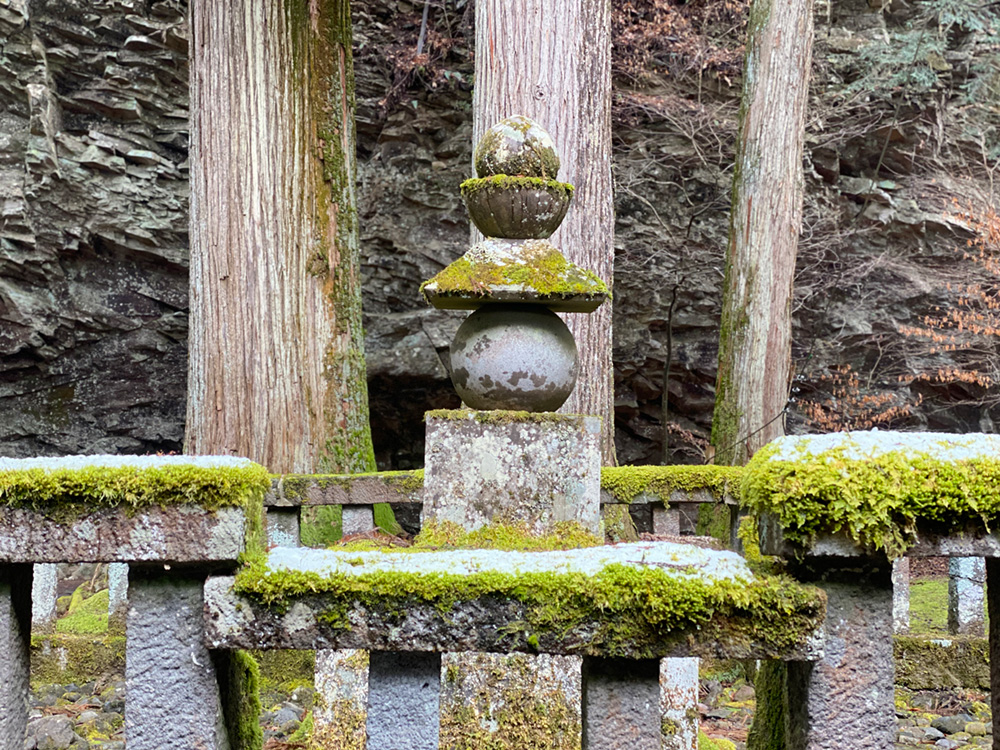勝道上人の墓
Grave of Shodo Shonin
胜道上人之墓
勝道上人之墓
쇼도 쇼닌의 무덤
Tombe de Shōdō Shōnin
Grab von Shodo Shonin
Tumba de Shodo Shonin
หลุมฝังศพของท่านปรมาจารย์โชโด (Shodo)

日光開山の祖、勝道上人(735−817)は、弘仁8年(817)3月1日に83歳で遷化され、仏岩で茶毘にふされました。当初、上人の遺骨は仏岩谷の上方に埋葬されましたが、東照宮鎮座のおり、開山堂が建てられ遺骨もここに移されました。五輪塔の台石には「勝道上人之墓」と刻まれています。また、隣にある三基は、上人の弟子のお墓です。
Inside the fence is the grave of the ascetic monk Shodo Shonin (735–817), founder of the Nikko-zan shrine-temple complex that is the forerunner of Rinnoji Temple. Shodo’s cremated remains were first buried in the upper reaches of this valley and were later moved to this location when the Founder’s Hall was built around 1620, soon after the consecration of Toshogu Shrine.
Shodo Shonin’s grave is marked by a stone a five-ringed pagoda (gorinto). Although gorinto are now common grave markers throughout Japan, initially they were only used by Esoteric Buddhist sects such as Shingon and Tendai. Rinnoji is a Tendai temple.
The five levels of gorinto represent the five fundamental elements with five different shapes. Starting from the bottom, the cube represents earth; the sphere represents water; the triangle represents fire; the crescent represents wind or air; and a globular shape on top represents void or energy. This top shape varies in different parts of the world; in Japan it is often the shape of a lotus bud.
The other graves nearby are those of Shodo’s disciples.
围墙内是苦行僧胜道上人(735–817)的坟墓,胜道上人是轮王寺的前身——日光山神社和寺庙建筑群的创始人。胜道的骨灰原本被埋葬在这个山谷上游,后来东照宫落成后不久,1620年左右开山堂建成,便迁到了现在的位置。
胜道上人的墓以五轮塔为标志。尽管五轮塔现在已成为全日本常见的墓碑标志,但最初它们仅为真言宗和天台宗等佛教密教所用。轮王寺是一座天台宗寺庙。
五轮塔的五层用不同的形状代表五个基本元素。从下而上,立方体代表地、球体代表水、三角形代表火、月牙代表风或空气、顶部的小球形代表空或能量。顶部的形状在世界各地有所不同。在日本,通常是莲花花蕾的形状。
附近的其他坟墓里葬着胜道的门徒。
圍牆內是苦行僧勝道上人(735–817)的墳墓,勝道上人是輪王寺的前身——日光山神社和寺廟建築群的創始人。勝道的骨灰原本被埋葬在這個山谷上游,後來東照宮落成後不久,1620年左右開山堂建成,便遷到了現在的位置。
勝道上人的墓以五輪塔為標誌。儘管五輪塔現在已成為全日本常見的墓碑標誌,但最初它們僅為真言宗和天臺宗等佛教密教所用。輪王寺是一座天臺宗寺廟。
五輪塔的五層用不同的形狀代表五個基本元素。從下而上,立方體代表地、球體代表水、三角形代表火、月牙代表風或空氣、頂部的小球形代表空或能量。頂部的形狀在世界各地有所不同。在日本,通常是蓮花花蕾的形狀。
附近的其他墳墓裡葬著勝道的門徒。
울타리 안에는 린노지 사찰의 전신, 닛코잔 신사 사찰 단지의 창건자인 고행승 쇼도 쇼닌(735-817)의 무덤이 있습니다. 쇼도의 화장된 유해는 원래 이 계곡의 상류에 묻혔는데, 도쇼구 신사가 지어진 직후인 1620년경 가이잔도가 지어졌을 때 이 위치로 옮겨졌습니다.
쇼도 쇼닌의 무덤에는 다섯 고리가 있는 돌탑(고린토)이 있습니다. 고린토는 현재 일본 전역에서 흔하게 볼 수 있는 무덤 표식이지만 처음에는 진언종과 천태종 같은 밀교 종파에서만 사용되었습니다. 린노지는 천태종 사찰입니다.
5층으로 된 고린토는 5가지 다른 모양으로 5가지 기본 요소를 나타냅니다. 바닥에서 시작하여 정육면체는 지구, 구는 물, 삼각형은 불, 초승달은 바람 또는 공기, 상단의 구형은 공허함 또는 에너지를 나타냅니다. 상단 모양은 세계 각지에서 다른 모양을 띕니다. 일본에서는 연꽃 봉오리 모양이 흔합니다.
근처의 다른 무덤은 제자들의 무덤입니다.
À l'intérieur de la clôture se trouve la tombe du moine ascétique Shōdō Shōnin (735 - 817), fondateur du complexe sanctuaire-temple Nikkō-zan qui est le précurseur du temple Rinnō-ji. La dépouille incinérée de Shōdō fut d'abord enterrée dans la partie supérieure de cette vallée et ensuite déplacée vers cet endroit, où le hall des fondateurs fut construit autour de 1620, peu après la consécration du sanctuaire Tōshō-gū.
La tombe de Shōdō Shōnin est marquée par une pagode à cinq anneaux en pierre (Gorintō). Bien que les Gorintō soient maintenant des pierres tombales communes dans tout le Japon, elles n'étaient initialement utilisées que par des sectes bouddhistes ésotériques telles que Shingon et Tendai. Rinnō-ji est un temple de la secte Tendai.
Les cinq niveaux du Gorintō représentent les cinq éléments fondamentaux à l’aide de cinq formes différentes. En partant du bas, le cube représente la terre, la sphère représente l'eau, le triangle représente le feu, le croissant représente le vent ou l'air et une forme de globe sur le dessus représente le vide ou l'énergie. Cette forme supérieure varie dans différentes parties du monde : au Japon, il a souvent la forme d'un bouton de lotus.
Les autres tombes se trouvant à proximité sont celles des disciples de Shōdō.
Innerhalb des Zauns befindet sich das Grab des asketischen Mönchs Shodo Shonin (735–817), Gründer der Nikkozan-Schrein-Tempelanlage, der der Vorläufer des Rinnoji-Tempels ist. Die eingeäscherten Überreste Shodos wurden zuerst im Oberlauf des Tales begraben und später an diesen Ort gebracht, als die Halle des Gründers um 1620 gebaut wurde – kurz nach der Einweihung des Toshogu-Schreins.
An Shodo Shonins Grab steht eine steinerne Fünf-Ringe-Pagode (Gorinto). Obwohl der Gorinto heute in ganz Japan üblicherweise als Grabstein eingesetzt wird, wurde er anfangs nur von esoterisch-buddhistischen Schulen wie Shingon und Tendai verwendet. Der Rinnoji ist ein Tendai-Tempel.
Die fünf Ebenen des Gorinto repräsentieren die fünf Grundelemente in fünf verschiedenen Formen. Von unten beginnend repräsentiert der Würfel die Erde; die Kugel steht für Wasser; das Dreieck steht für Feuer; der Halbmond steht für Wind oder Luft; und eine Kugelform oben repräsentiert Leere oder Energie. Die Spitze ist überall unterschiedlich. In Japan hat sie oft die Form einer Lotusknospe.
Die anderen Gräber in der Nähe sind die von Shodos Schülern.
Dentro de la cerca se encuentra la tumba del monje ascético Shodo Shonin (735–817), fundador del complejo de templos y santuarios de Nikko-zan, precursor del templo Rinnoji. Los restos incinerados de Shodo fueron enterrados originalmente en la parte alta del valle y más tarde se trasladaron a este lugar, cuando se construyó el Pabellón del Fundador, alrededor de 1620, poco después de la consagración del santuario Toshogu.
La tumba de Shodo Shonin está marcada por una pagoda de piedra de cinco anillos (gorinto). Aunque las gorinto son ahora marcadores de tumbas comunes en todo Japón, inicialmente solo las utilizaban sectas budistas esotéricas como Shingon y Tendai. Rinnoji es un templo Tendai.
Los cinco niveles de la gorinto representan los cinco elementos fundamentales con cinco formas diferentes. Comenzando desde abajo, el cubo representa la tierra; la esfera representa el agua; el triángulo representa el fuego; la media luna representa el viento o el aire, y la forma globular de la parte superior representa el vacío o la energía. La forma de la parte superior varía en diferentes partes del mundo; en Japón suele tener la forma de un capullo de loto.
Las otras tumbas cercanas son las de los discípulos de Shodo.
ภายในรั้ว คือ หลุมฝังศพของพระปรมาจารย์โชโด (Shodo) (ค.ศ. 735-817) ผู้ก่อตั้งกลุ่มวัดและศาลเจ้านิกโกซังซึ่งเป็นผู้บุกเบิกวัดรินโนจิ (Rinnoji) ร่างของท่านปรมาจารย์โชโดได้รับการเผาและถูกฝังเป็นครั้งแรกในต้นน้ำลำธารของหุบเขานี้ ต่อมาเมื่อหอผู้ก่อตั้งถูกสร้างขึ้นราว ค.ศ.1620 ได้ไม่นานหลังจากการถวายอุทิศของศาลเจ้าโทโชกุ (Toshogu) ก็ได้ถูกย้ายมายังสถานที่แห่งนี้
หลุมฝังศพของปรมาจารย์โชโดได้รับการทำเครื่องหมายด้วยหินเจดีย์ห้าวงแหวนโกรินโต (Gorinto) แม้ว่าโกรินโตจะเป็นเครื่องหมายหลุมศพที่ใช้กันทั่วไปในญี่ปุ่น แต่เมื่อแรกเริ่มได้ถูกใช้โดยพระพุทธศาสนานิกายวัชรยาน เช่น ชินกอน (Shingon) และเท็นได (Tendai) เท่านั้น ซึ่งวัดรินโนจิเป็นวัดในนิกายเท็นได
ทั้งห้าระดับของโกรินโตแสดงถึงองค์ประกอบพื้นฐานทั้งห้าที่มีรูปร่างแตกต่างกันห้าแบบ เริ่มจากด้านล่างรูปลูกบาศก์หมายถึงโลก ทรงกลมหมายถึงน้ำ สามเหลี่ยมหมายถึงไฟ พระจันทร์เสี้ยวหมายถึงลมหรืออากาศ และรูปทรงกลมด้านบนสุดแสดงถึงความว่างหรือพลังงาน รูปร่างส่วนบนยอดนี้แตกต่างกันไปตามส่วนต่างๆของโลก ในญี่ปุ่นมักจะเป็นรูปดอกบัวตูม
หลุมฝังศพอื่นที่อยู่ใกล้ ๆ คือ หลุมฝังศพของเหล่าศิษย์ของท่านปรมาจารย์โชโด
